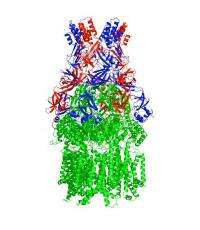Researchers describe the pump that bacteria use to resist drugs

A research team led by Edward Yu of Iowa State University and the Ames Laboratory has identified and described two parts of the three-part system that pumps toxins from bacteria and allows them to resist antibiotics.
The discoveries are published in the Feb. 24 issue of the journal Nature.
The paper describes the co-crystal structure of two parts of the three-part efflux pump that recognizes and removes heavy metal toxins from bacteria. A research team led by Yu – an Iowa State associate professor of physics and astronomy, of chemistry, of biochemistry, biophysics and molecular biology and an associate of the U.S. Department of Energy's Ames Laboratory – is working to discover the assembled structure of the entire three-part efflux pump.
Yu said a better understanding of how the three parts work together could help medical researchers find ways to restore the effectiveness of antibiotics.
"These pumps have to assemble together in order to pump out heavy metals and antibiotics," Yu said. "Researchers may be able to use these findings to design an inhibitor so the pump can't be assembled and can't work."
Yu and his research team described the first part of the pump – the inner membrane transporter known as CusA – in the Sept. 23, 2010, issue of the journal Nature.
The current paper describes the inner membrane transporter and how it interacts with the pump's middle adapter, known as CusB. The two parts together are known as the CusBA complex.
The research was supported by grants from the National Institutes of Health. In addition to Yu, the research team includes Robert Jernigan, an Iowa State professor of biochemistry, biophysics and molecular biology and director of Iowa State's Laurence H. Baker Center for Bioinformatics and Biological Statistics; Kanagalaghatta Rajashankar, the operations team leader for the Northeastern Collaborative Access Team facility at Argonne National Laboratory in Argonne, Ill., that's managed by Cornell University in Ithaca, N.Y.; Iowa State post-doctoral researchers Chih-Chia Su and Feng Long; and Iowa State graduate student Michael Zimmermann.
"Determining the structure of CusBA represents a remarkable achievement that has enabled Dr. Yu and his collaborators to model the structure of the entire CusCBA complex," said Jean Chin, who oversees structural biology grants at the National Institutes of Health. "This advance has brought novel insights on how the transporter functions and could lead to ways to block its activity and heighten bacteria's sensitivity to antibiotics."
To make their findings, the researchers purified and co-crystallized the proteins that make up the transporter and adaptor parts of the efflux pump from E. coli bacteria. Then they used X-ray crystallography, including a technique called molecular replacement with single-wavelength anomalous dispersion, to determine the structure and interaction of the two parts.
The studies revealed, molecule by molecule, how the inner transporter's three molecules bind and interact with the middle adaptor's six molecules. The studies also revealed the adaptors' six molecules form a funnel-like channel extending from the top of the transporter.
The researchers used those discoveries to predict how the three-molecule structure of the pump's third part, the outer membrane channel known as CusC, interacts with the CusBA complex.
Yu said discovering the structure of the toxin pump is a significant step toward a better understanding of bacterial resistance to antibiotics.
"A crystallographic model of this tripartite efflux complex has been unavailable," the researchers wrote in a summary of their latest Nature paper, "simply because co-crystallization of different components of the system has proven to be extremely difficult."



















